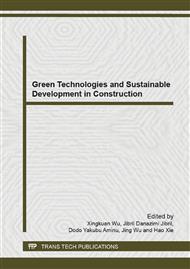p.307
p.312
p.316
p.320
p.323
p.329
p.333
p.337
p.342
The Influence of Ventilation on Reducing Temperature in Subtropical Dwellings via Enthalpy
Abstract:
The study was conducted under the humid condition of subtropical climate to investigate the correlation between the cooling effect linked with ventilation and space utility of building dwellings. The electric oil-filed radiator heater was utilized to simulate indoor thermal source to carry out the experiment on ventilation at the exchange rate of 0.1m3/s per hour within a dwelling space measured of 47.3m3 and hourly record of changes to temperature, humidity and air enthalpy was performed. The result revealed that as far as the subtropical humid climate is concerned, dehumidifying efficiency of indoor ventilation was found better than cooling efficiency. Whether the thermal source was produced in the indoor space or not, the indoor absolute humidity reduced with the existence of ventilation and it reached the balance of outdoor air. It represented a difference of 80% within a 10-minute interval on regulating indoor environment.
Info:
Periodical:
Pages:
342-346
Citation:
Online since:
May 2014
Authors:
Keywords:
Price:
Сopyright:
© 2014 Trans Tech Publications Ltd. All Rights Reserved
Share:
Citation:


